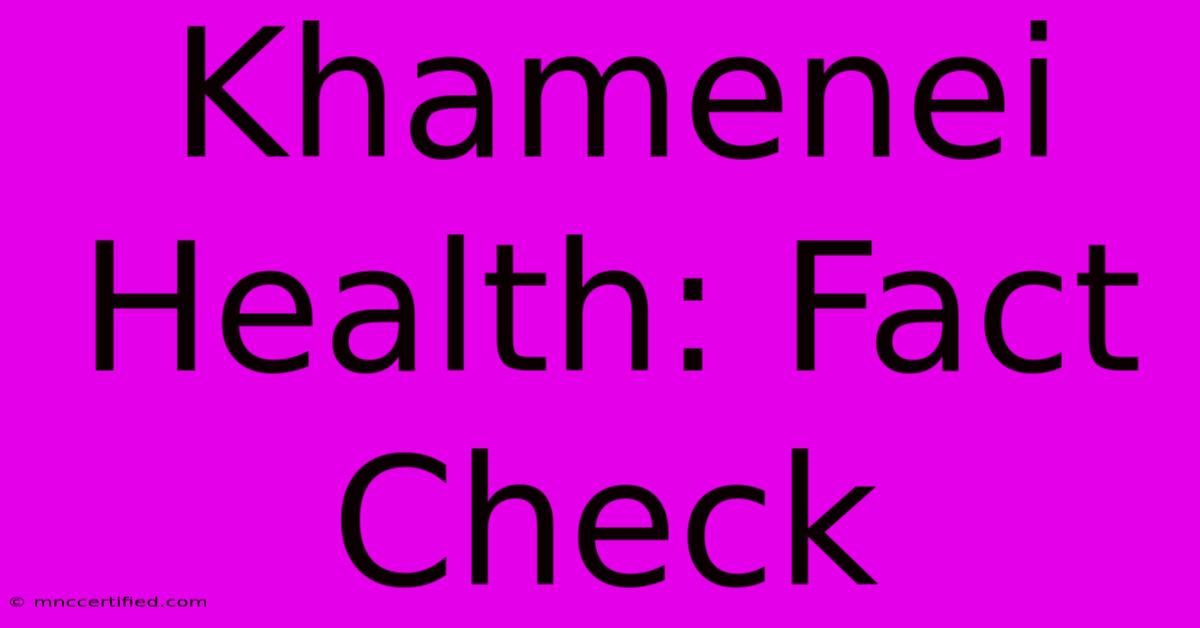Khamenei Health: Fact Check

Table of Contents
Khamenei Health: Fact Check – Separating Fact from Speculation
The health of Ayatollah Ali Khamenei, Supreme Leader of Iran, is a subject of persistent speculation and rumor. Information is often scarce, controlled, and conflicting, making it challenging to ascertain the truth. This article aims to provide a fact-check of circulating claims, separating credible information from unsubstantiated rumors, and analyzing the implications of the limited transparency surrounding his health.
The Challenge of Verifying Information
Verifying information regarding Ayatollah Khamenei's health is exceptionally difficult due to several factors:
- State Secrecy: Iran's government tightly controls information flow related to the Supreme Leader's health, often releasing minimal details or none at all. This lack of transparency fuels speculation and the spread of misinformation.
- Conflicting Reports: Reports from various sources, including international media outlets, Iranian dissident groups, and social media, often contradict each other, making it hard to determine reliability. Many reports lack verifiable sources or rely on anonymous informants.
- Propaganda and Disinformation: Both pro- and anti-government actors intentionally spread misinformation to advance their agendas. This deliberate manipulation further complicates the task of verifying claims.
Debunking Common Myths and Rumors
Several recurring claims about Ayatollah Khamenei's health have circulated online. Let's examine some of the most prevalent:
Myth 1: Khamenei is suffering from a terminal illness.
Fact Check: There is no credible evidence to support this claim. While rumors of various illnesses, from Parkinson's disease to prostate cancer, have surfaced, they lack verifiable sources. Official statements from Iranian authorities are limited and often vague, making it impossible to confirm or deny these reports definitively.
Myth 2: Khamenei's recent appearances show signs of deteriorating health.
Fact Check: Analyzing his public appearances requires caution. While some observers point to visible signs of age and potential health issues, such as trembling or fatigue, these observations are subjective and open to interpretation. Without access to medical records, these observations cannot be definitively linked to specific medical conditions.
Myth 3: The Iranian government is hiding the truth about his health.
Fact Check: This is highly likely. The Iranian government's control over information regarding the Supreme Leader's health strongly suggests a deliberate effort to control the narrative and prevent potential instability. The lack of transparency is itself a significant indicator of the government's intention to manage public perception.
The Implications of Information Control
The opacity surrounding Ayatollah Khamenei's health has significant implications:
- Political Instability: Uncertainty about the Supreme Leader's health can potentially destabilize Iranian politics, leading to internal power struggles and speculation about succession.
- International Relations: The health of the Supreme Leader can influence Iran's foreign policy and its relations with other countries. Uncertainty about his condition could affect international negotiations and alliances.
- Economic Impacts: The lack of transparency can impact investor confidence and affect the Iranian economy, as uncertainty about the leadership's future can deter investment.
Conclusion: The Need for Critical Evaluation
The health of Ayatollah Khamenei remains a subject shrouded in secrecy. While rumors abound, credible, verifiable information remains scarce. It's crucial to critically evaluate sources and avoid spreading unsubstantiated claims. The lack of transparency highlights the need for responsible reporting and a reliance on factual evidence rather than speculation. Until official and verifiable information is released, any assertions regarding the Supreme Leader's health should be treated with extreme caution.

Thank you for visiting our website wich cover about Khamenei Health: Fact Check. We hope the information provided has been useful to you. Feel free to contact us if you have any questions or need further assistance. See you next time and dont miss to bookmark.
Featured Posts
-
I M A Celebrity 2024 Tulisas Post X Factor Life
Nov 18, 2024
-
Social Work Malpractice Insurance
Nov 18, 2024
-
Dublin Airport Traffic Affected Alert Issued
Nov 18, 2024
-
Patriots Rams Game Rams Secure Victory
Nov 18, 2024
-
Colts Vs Jets Week 11 Richardson Preview
Nov 18, 2024